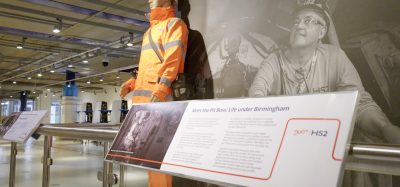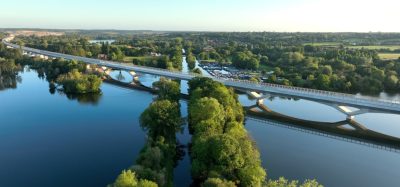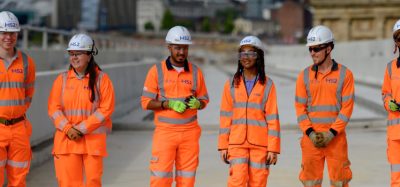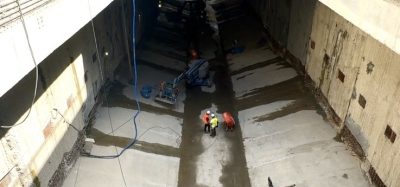Tunnel construction through the Hallandsås Ridge – a world-class project
Posted: 26 September 2009 | | No comments yet
Construction of a tunnel through the Hallandsås Ridge in southwest Sweden has given rise to many emotions over the years and the project has suffered several setbacks. Yet because of, or perhaps thanks to, its history, the tunnel is now one of Sweden’s most well-planned construction projects. Today, the project has Swedish and international expertise of world-class, and environmental and safety standards are rigorous.
Construction of a tunnel through the Hallandsås Ridge in southwest Sweden has given rise to many emotions over the years and the project has suffered several setbacks. Yet because of, or perhaps thanks to, its history, the tunnel is now one of Sweden's most well-planned construction projects. Today, the project has Swedish and international expertise of world-class, and environmental and safety standards are rigorous.
Construction of a tunnel through the Hallandsås Ridge in southwest Sweden has given rise to many emotions over the years and the project has suffered several setbacks. Yet because of, or perhaps thanks to, its history, the tunnel is now one of Sweden’s most well-planned construction projects. Today, the project has Swedish and international expertise of world-class, and environmental and safety standards are rigorous.
General overview
The tunnel through the Hallandsås Ridge is part of the West Coast Line and one of several projects included in the current expansion of Sweden’s rail network. The West Coast Line connects two of Sweden’s largest cities with extensions to the capital cities of Oslo and Copenhagen. To date, 85% of the West Coast Line has been expanded to double track, but several bottlenecks remain. One of them is the section across the Hallandsås Ridge.
The Hallandsås Ridge is a raised fault block that is 40km-long and 10km-wide and rises 226m above sea level in an otherwise flat landscape. An old single track from 1885 currently crosses the ridge. Due to the track’s steep rises and sharp curves, heavy trains cannot cross the ridge and that the number of trains that can pass is severely limited.
With a tunnel through the ridge, trains that are twice as heavy will be able to pass. Capacity will increase from today’s four trains per hour to 24 trains per hour, and some 20 dangerous railway crossings will be eliminated. The ultimate aim of the Swedish government’s decision to improve Sweden’s railways is to shift more transports away from roads to a safer and more environmentally friendly alternative. On the motorway over the ridge, more than 20,000 vehicles pass each day, representing more than a doubling over the past 15 years.
Previous / History / What has happened?
Construction of the tunnel began in 1992 when the company Kraftbyggarna was selected as contractor for the project. The company proposed an open tunnel boring machine (TBM) technique. However, this choice of technology proved to be wrong, since the machine almost immediately got stuck in the rock. Work continued with traditional drilling and blasting methods but was greatly delayed. After a while, the assignment was awarded to Skanska, but that company also encountered problems.
In the late 1990s, when excessive volumes of groundwater flowed into the tunnel, a chemical sealant called Rhoca Gil was chosen to stop the flow. At that time, Rhoca Gil was used widely in the construction industry. However, due to the substantial flows of water in the rock, the sealant was not able to harden, and some of it ran out of the tunnel with the leaking water. Three cows that drank contaminated stream water became paralyzed. An alarm was sounded, and the project came to a halt.
Knowledge about what had happened was poor at that time. This had the result that animals were slaughtered and crops in the area were destroyed. After construction was halted in the autumn of 1997, several intensive years of investigations, corrective measures, legal processes, damage claims and consultations awaited. Substantial resources were devoted to rectifying the effects of the accident. Today it is clear that the effects of the Rhoca Gil leakage were less severe than feared, and the Hallandsås Ridge was long ago declared healthy.
The Hallandsås Ridge is a so called horst from the Achaean period, or raised fault block, of greatly varying quality, from solid rock in which drilling is possible to very decomposed rock and clay in places. The difficulties in the construction of this particular tunnel lie in the constant challenge of mastering the ridge’s complicated geology in combination with very high water pressure and water flows. The water pressure at the tunnel level is as high as 15 bars in places.
Since the project was restarted in 2003, the Swedish Rail Administration has received a permit from the Swedish Environmental Court to release 100 litres of water as a 30-day average value during the construction period. The permit also stipulates that the project’s general contractor, the Swedish-French consortium Skanska-Vinci, must use what is called a shielded TBM. The drill is specially designed for the Hallandsås Ridge and can be adapted to different geological conditions. To limit the ability of groundwater to leak into the tunnel, the TBM builds a concrete lining in the form of a waterproof tube directly behind the cutter head. Leakage can thus only occur in a limited area that is also moved forward at the same rate as the TBM moves forward. This means that, compared with other methods, the impact on groundwater levels is limited and the environmental impact is reduced.
The TBM is normally operated in an open position in which the groundwater flows through the machine’s cutter head and the rock material is transported out on a conveyor belt. When the rock is decomposed and contains considerable amounts of water, the machine can be operated in a closed position. In this mode, the machine is pressurised at a pressure that normally equals the water pressure in the surrounding rock. In the meantime, the rock is strengthened through cement grouting. In this pre-treatment, 15m to 40m-long holes are drilled into the rock and filled with cement. The TBM normally produces 100m to 150m of tunnel per month, depending on how much water the rock contains. In drier conditions, the machine has produced slightly more than 250m of tunnel per month.
The TBM drills its way forward by bracing itself against the completed concrete lining, which consists of concrete rings, each composed of eight pre-fabricated concrete segments. These segments are 2.2m-wide and weigh 12 tonnes each. The space between the rock wall and the concrete lining is filled with peagravel that is grouted with cement to stabilise the tube and prevent continued water flow.
Toward the autumn, the TBM will pass through the 300m-wide Mölleback zone, which is the ridge’s most difficult geological zone with decomposed rock and very strong water flows in certain places. To ensure safe drilling with the TBM through this area, the rock has been stabilised in part with cement and in part by freezing.
As early as 2006, freezing began of a 130m-long cylinder-shaped area with a diameter of 15m in the eastern tunnel. To freeze the rock, a number of horizontal holes were drilled in the area to be frozen. A saline solution with a temperature of minus 40 degrees was then circulated in these holes using a method that is similar to freezing of a hockey rink. The pre-treatment and freezing of the Mölleback zone is now complete. At present, only maintenance freezing is required until the TBM passes through the area some time before Christmas.
The environment and controls
The problems that the project encountered during the 1990s generated important experience and lessons. One of the lessons that the Hallandsås Ridge project and the construction industry in general learned from these problems was the importance of identifying and eliminating risks. (Skanska first certified construction company).
The tunnel project’s area of influence, which measures approximately 30km2, includes some 1,000 checkpoints where water, nature and ecology are carefully monitored. Groundwater levels alone are measured in a total of 440 wells along the entire length of the tunnel. Surface water also undergoes extensive testing. This includes water in streams, dams, marshes and springs, as well as measurements of rainfall, since the amount of precipitation affects both surface and groundwater.
On the initiative of a local nature protection society, a special ecological control programme was started in 1999, which is managed by a working group that is independent of the Swedish Rail Administration and includes representatives of various authorities and organisations. The objective of the programme is to assess the impact of the tunnel construction on the natural environment in both a short and long-term perspective. There are no similar programmes in Sweden, and over the ten years of its existence, it has become a scientific programme that has amassed large amounts of valuable data.
Safety in the completed tunnel
Safety in the Hallandsås Ridge tunnel will meet all the requirements currently placed on a modern railway tunnel in Sweden and the EU. The Swedish Rail Administration is also planning a number of measures to further optimise safety; for example, the tunnel will be monitored with motion detectors and TV cameras. Signal sections will be lengthened and, for particularly important functions, power outages will be counteracted by battery operation. Fire protection in the tunnel will consist of polypropylene fibre. For each cubic metre of concrete, one kilogram of plastic fibre is added. The effect in case of fire is that the fibres will melt and the chemically bonded water in the concrete will be able to expand without cracking the concrete, thus reducing the risk of collapse in the case of a possible fire. However, the risk of a fire starting in the tunnel is minimal.
Current status of the project in terms of time schedule and investments
The tunnel boring machine called Åsa has now built more than 4,000m of sealed tunnel. Together with previously built portions, a total of 62% of the two parallel 8.6km tunnels through the Hallandsås Ridge have been completed. In the eastern tunnel, where the TBM is working today, slightly more than 1,000m of tunnel remain to be built until it breaks through in Båstad during the spring of 2010. At that time, the cutter head will be dismantled and the TBM will be backed out to the main worksite to the south, where it will be re-assembled and begin work in the western tunnel. This move will take approximately six months, and work in the western tunnel is expected to begin in the autumn of 2010.
Although the pace of construction has gradually increased, it has been slower than anticipated since construction was restarted in 2003. The project has considered ways of increasing the speed of construction, but neither a change in construction method nor an additional TBM have been found to be satisfactory solutions (Environmental Court ruling). As of the autumn of 2008, the project is subject to a new timetable, and the first train is now scheduled to pass through the tunnel in 2015.
From 1992 to 2002, the project cost SEK 2.1 billion. In 2003, the project was restarted using a new technological method. From the restart of the project, the budget has been set at SEK 8.4 billion in 2008 monetary values. he total cost of the project will thus be SEK 10.5 billion.
Conclusion
The tunnel through the Hallandsås Ridge is part of the expansion of the West Coast Line, which is one of Sweden’s most important rail links. It not only links people, cities, regions and countries together; it also creates opportunities for safe, efficient and environmentally friendly transport.
It is one of the most important Swedish railway projects by far for two reasons. The first is that railways must be built where there are many people, and there are a lot of people along the entire west coast. This makes it possible to expand the labour market region for very many people. The second is that it increases the railway’s advantages over the road.
It eases the environmental load. I.e. E6 motorway/environment/increased transports in recent years, etc. It is important to shift transports to a more environmentally friendly alternative.
The tunnel through the Hallandsås Ridge is an important part of a modern transport system that benefits everyone living in Sweden. A modern society must constantly change and develop. However, the time when development could take place at the expense of the environment is past. Accordingly, the tunnel is an investment in our shared future.
Global Railway Review Autumn/ Winter Issue 2025
Welcome to 2025’s Autumn/ Winter issue of Global Railway Review!
The dynamism of our sector has never been more apparent, driven by technological leaps, evolving societal demands, and an urgent global imperative for sustainable solutions.
>>> Read the issue in full now! <<<







